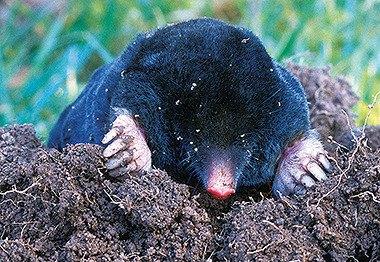Sussex Wildlife Trust: ...and I live in a hole
November 1st, 2020 It’s hard to bond with the mole. Like 99.9% of us, I’ve never seen one and probably never will. They’re almost a supernatural entity – the Bigfoot of the back garden
It’s hard to bond with the mole. Like 99.9% of us, I’ve never seen one and probably never will. They’re almost a supernatural entity – the Bigfoot of the back gardenIf your lawn is full of nectar-rich flowers for butterflies and bees, with a patch of long grass for grasshoppers and hedgehogs, then Mother Nature will thank you. But if you’re one of those particular people who demands that their lawn is a perfectly manicured carpet, slathered in chemicals and shamelessly shaved each summer Sunday, then Mother Nature will not be happy and she’ll send in her best hit man. So while we remember, remember Guy Fawkes in November, I’m here to celebrate Britain’s other infamous tunnelling terrorist – the mole.
It’s hard to bond with the mole. Like 99.9% of us, I’ve never seen one and probably never will. They’re almost a supernatural entity – the Bigfoot of the back garden. Their invisibility means my mental image of the mole has been painted by The Wind in the Willows and children’s cartoons instead of real-life encounters. I’m always surprised when I see an actual photo of one and it’s not wearing glasses.
Moles aren’t blind. Admittedly, they’ll be struggling by the second line of an eye test but there isn’t much call for perfect eyesight when you spend all your life in total darkness. Instead, their pink nose is covered with 5,000 sensory organs which register touch and vibration, allowing the mole to ‘see’ with its snout; a super-sense that makes them efficient hunters.
Their tunnel network spreads out like an underground web and when a wiggling worm drops into it the mole’s super-senses tingle, sending them scrambling through their pitch-black passageways. Worms are captured, cleaned, beheaded and stored, still wriggling, in a larder for future consumption.
The mole’s front paws are like a pair of giant pink snow-shovels and come equipped with an extra thumb; a characteristic they share with the giant panda. These wide shovel-hands can move an incredible 540 times their own weight of soil in a day. That’s like me moving 55.46 tonnes of mud (and before you go scrambling for your calculators, yes, I could do with losing a few pounds).
The molehills that erupt on our lawns are spoil heaps created by the construction work below. OK –they’re unsightly but gardeners should be welcoming moles. When potted, molehill soil makes an excellent growing medium for seeds and seedlings, so if you’re blessed with molehills - grab a trowel. Once the tunnels are completed the molehills will stop appearing and, in the long run, mole burrowing bestows untold benefits to soil aeration and quality. But for me, it’s a pleasure just knowing that such an amazing animal is living, unseen, a few inches below my feet. Some people will still complain but I guess some folk will always make a mountain out of a, well, y’know.
By Michael Blencowe:
Learning & Engagement Officer, Sussex Wildlife Trust
Sussex Wildlife Trust is an independent registered charity caring for wildlife and habitats throughout Sussex. Founded in 1961, we rely on the support of our members to help protect our rich natural heritage. Please consider supporting our work. As a member you will be invited to join Michael Blencowe on our regular wildlife walks and also enjoy free events, discounts on wildlife courses, Wildlife magazine and our guide book: Discovering Wildlife in Sussex.
It’s easy to join online at: www.sussexwildlifetrust.org.uk/join or T: 01273 497532.
Mole Ray Armstrong Sussex Wildlife Trust
It’s hard to bond with the mole. Like 99.9% of us, I’ve never seen one and probably never will. They’re almost a supernatural entity – the Bigfoot of the back garden. Their invisibility means my mental image of the mole has been painted by The Wind in the Willows and children’s cartoons instead of real-life encounters. I’m always surprised when I see an actual photo of one and it’s not wearing glasses.
Moles aren’t blind. Admittedly, they’ll be struggling by the second line of an eye test but there isn’t much call for perfect eyesight when you spend all your life in total darkness. Instead, their pink nose is covered with 5,000 sensory organs which register touch and vibration, allowing the mole to ‘see’ with its snout; a super-sense that makes them efficient hunters.
Their tunnel network spreads out like an underground web and when a wiggling worm drops into it the mole’s super-senses tingle, sending them scrambling through their pitch-black passageways. Worms are captured, cleaned, beheaded and stored, still wriggling, in a larder for future consumption.
The mole’s front paws are like a pair of giant pink snow-shovels and come equipped with an extra thumb; a characteristic they share with the giant panda. These wide shovel-hands can move an incredible 540 times their own weight of soil in a day. That’s like me moving 55.46 tonnes of mud (and before you go scrambling for your calculators, yes, I could do with losing a few pounds).
The molehills that erupt on our lawns are spoil heaps created by the construction work below. OK –they’re unsightly but gardeners should be welcoming moles. When potted, molehill soil makes an excellent growing medium for seeds and seedlings, so if you’re blessed with molehills - grab a trowel. Once the tunnels are completed the molehills will stop appearing and, in the long run, mole burrowing bestows untold benefits to soil aeration and quality. But for me, it’s a pleasure just knowing that such an amazing animal is living, unseen, a few inches below my feet. Some people will still complain but I guess some folk will always make a mountain out of a, well, y’know.
By Michael Blencowe:
Learning & Engagement Officer, Sussex Wildlife Trust
Sussex Wildlife Trust is an independent registered charity caring for wildlife and habitats throughout Sussex. Founded in 1961, we rely on the support of our members to help protect our rich natural heritage. Please consider supporting our work. As a member you will be invited to join Michael Blencowe on our regular wildlife walks and also enjoy free events, discounts on wildlife courses, Wildlife magazine and our guide book: Discovering Wildlife in Sussex.
It’s easy to join online at: www.sussexwildlifetrust.org.uk/join or T: 01273 497532.
Mole Ray Armstrong Sussex Wildlife Trust
Comments (0)
No comments have been submitted yet.Why not be the first to send us your thoughts
Leave A Comment
Thank you for your comments, they will appear shortly once approved.
Recent Posts
Have You Seen...






